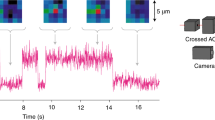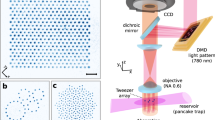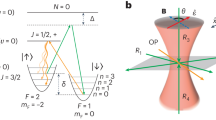Abstract
Polyatomic molecules have rich structural features that make them uniquely suited to applications in quantum information science1,2,3, quantum simulation4,5,6, ultracold chemistry7 and searches for physics beyond the standard model8,9,10. However, a key challenge is fully controlling both the internal quantum state and the motional degrees of freedom of the molecules. Here we demonstrate the creation of an optical tweezer array of individual polyatomic molecules, CaOH, with quantum control of their internal quantum state. The complex quantum structure of CaOH results in a non-trivial dependence of the molecules’ behaviour on the tweezer light wavelength. We control this interaction and directly and non-destructively image individual molecules in the tweezer array with a fidelity greater than 90%. The molecules are manipulated at the single internal quantum state level, thus demonstrating coherent state control in a tweezer array. The platform demonstrated here will enable a variety of experiments using individual polyatomic molecules with arbitrary spatial arrangement.
This is a preview of subscription content, access via your institution
Access options
Access Nature and 54 other Nature Portfolio journals
Get Nature+, our best-value online-access subscription
$29.99 / 30 days
cancel any time
Subscribe to this journal
Receive 51 print issues and online access
$199.00 per year
only $3.90 per issue
Buy this article
- Purchase on Springer Link
- Instant access to full article PDF
Prices may be subject to local taxes which are calculated during checkout




Similar content being viewed by others
Data availability
The data that support the findings of this study are available from the corresponding author on reasonable request. Source data are provided with this paper.
References
Yu, P., Cheuk, L. W., Kozyryev, I. & Doyle, J. M. A scalable quantum computing platform using symmetric-top molecules. New J. Phys. 21, 093049 (2019).
Wei, Q., Kais, S., Friedrich, B. & Herschbach, D. Entanglement of polar symmetric top molecules as candidate qubits. J. Chem. Phys. 135, 154102 (2011).
Tesch, C. M. & de Vivie-Riedle, R. Quantum computation with vibrationally excited molecules. Phys. Rev. Lett. 89, 157901 (2002).
Wall, M. L., Maeda, K. & Carr, L. D. Simulating quantum magnets with symmetric top molecules. Ann. Phys. (Berlin) 525, 845–865 (2013).
Wall, M., Hazzard, K. & Rey, A. M. in From Atomic To Mesoscale: The Role of Quantum Coherence in Systems of Various Complexities (eds Malinovskaya, S. & Novikova, I.) 3–37 (World Scientific, 2015).
Wall, M., Maeda, K. & Carr, L. D. Realizing unconventional quantum magnetism with symmetric top molecules. New J. Phys. 17, 025001 (2015).
Heazlewood, B. R. & Softley, T. P. Towards chemistry at absolute zero. Nat. Rev. Chem. 5, 125–140 (2021).
Kozyryev, I. & Hutzler, N. R. Precision measurement of time-reversal symmetry violation with laser-cooled polyatomic molecules. Phys. Rev. Lett. 119, 133002 (2017).
Kozyryev, I., Lasner, Z. & Doyle, J. M. Enhanced sensitivity to ultralight bosonic dark matter in the spectra of the linear radical SrOH. Phys. Rev. A 103, 043313 (2021).
Hutzler, N. R. Polyatomic molecules as quantum sensors for fundamental physics. Quantum Sci. Technol. 5, 044011 (2020).
Micheli, A., Brennen, G. & Zoller, P. A toolbox for lattice-spin models with polar molecules. Nat. Phys. 2, 341–347 (2006).
Gorshkov, A. V. et al. Quantum magnetism with polar alkali-metal dimers. Phys. Rev. A 84, 033619 (2011).
DeMille, D. Quantum computation with trapped polar molecules. Phys. Rev. Lett. 88, 067901 (2002).
Yelin, S., Kirby, K. & Côté, R. Schemes for robust quantum computation with polar molecules. Phys. Rev. A 74, 050301 (2006).
Ni, K.-K., Rosenband, T. & Grimes, D. D. Dipolar exchange quantum logic gate with polar molecules. Chem. Sci. 9, 6830–6838 (2018).
Sawant, R. et al. Ultracold polar molecules as qudits. New J. Phys. 22, 013027 (2020).
Albert, V. V., Covey, J. P. & Preskill, J. Robust encoding of a qubit in a molecule. Phys. Rev. X 10, 031050 (2020).
Cheuk, L. W. et al. Observation of collisions between two ultracold ground-state CaF molecules. Phys. Rev. Lett. 125, 043401 (2020).
Kondov, S. S. et al. Molecular lattice clock with long vibrational coherence. Nat. Phys. 15, 1118–1122 (2019).
Norrgard, E. B. et al. Nuclear-spin dependent parity violation in optically trapped polyatomic molecules. Commun. Phys. 2, 1–6 (2019).
Endres, M. et al. Atom-by-atom assembly of defect-free one-dimensional cold atom arrays. Science 354, 1024–1027 (2016).
Barredo, D., Lienhard, V., de Léséleuc, S., Lahaye, T. & Browaeys, A. Synthetic three-dimensional atomic structures assembled atom by atom. Nature 561, 79–82 (2018).
Bluvstein, D. et al. A quantum processor based on coherent transport of entangled atom arrays. Nature 604, 451–456 (2022).
Kaufman, A. M. & Ni, K.-K. Quantum science with optical tweezer arrays of ultracold atoms and molecules. Nat. Phys. 17, 1324–1333 (2021).
Browaeys, A. & Lahaye, T. Many-body physics with individually controlled Rydberg atoms. Nat. Phys. 16, 132–142 (2020).
Levine, H. et al. Parallel implementation of high-fidelity multiqubit gates with neutral atoms. Phys. Rev. Lett. 123, 170503 (2019).
Evered, S. J. et al. High-fidelity parallel entangling gates on a neutral-atom quantum computer. Nature 622, 268–272 (2023).
Bernien, H. et al. Probing many-body dynamics on a 51-atom quantum simulator. Nature 551, 579–584 (2017).
Ebadi, S. et al. Quantum phases of matter on a 256-atom programmable quantum simulator. Nature 595, 227–232 (2021).
Scholl, P. et al. Quantum simulation of 2D antiferromagnets with hundreds of Rydberg atoms. Nature 595, 233–238 (2021).
Norcia, M. A. et al. Seconds-scale coherence on an optical clock transition in a tweezer array. Science 366, 93–97 (2019).
Madjarov, I. S. et al. An atomic-array optical clock with single-atom readout. Phys. Rev. X 9, 041052 (2019).
Young, A. W. et al. Half-minute-scale atomic coherence and high relative stability in a tweezer clock. Nature 588, 408–413 (2020).
Reynolds, L. A. et al. Direct measurements of collisional dynamics in cold atom triads. Phys. Rev. Lett. 124, 073401 (2020).
Anderegg, L. et al. An optical tweezer array of ultracold molecules. Science 365, 1156–1158 (2019).
Zhang, J. T. et al. An optical tweezer array of ground-state polar molecules. Quantum Sci. Technol. 7, 035006 (2022).
Ruttley, D. K. et al. Formation of ultracold molecules by merging optical tweezers. Phys. Rev. Lett. 130, 223401 (2023).
Holland, C. M., Lu, Y. & Cheuk, L. W. On-demand entanglement of molecules in a reconfigurable optical tweezer array. Science 382, 1143–1147 (2023).
Bao, Y. et al. Dipolar spin-exchange and entanglement between molecules in an optical tweezer array. Science 382, 1138–1143 (2023).
Bao, Y. et al. Raman sideband cooling of molecules in an optical tweezer array to the 3D motional ground state. Preprint at https://arxiv.org/abs/2309.08706 (2023).
Lu, Y., Li, S. J., Holland, C. M. & Cheuk, L. W. Raman sideband cooling of molecules in an optical tweezer array. Nat. Phys. 20, 389–394 (2024).
Augenbraun, B. L. et al. in Advances in Atomic, Molecular, and Optical Physics Vol. 72 (eds DiMauro, L. F., Perrin, H. & Yelin, S. F.) 89–182 (Academic, 2023).
Anderegg, L. et al. Quantum control of trapped polyatomic molecules for eEDM searches. Science 382, 665–668 (2023).
Takahashi, Y., Zhang, C., Jadbabaie, A. & Hutzler, N. R. Engineering field-insensitive molecular clock transitions for symmetry violation searches. Phys. Rev. Lett. 131, 183003 (2023).
Kozyryev, I. et al. Sisyphus laser cooling of a polyatomic molecule. Phys. Rev. Lett. 118, 173201 (2017).
Vilas, N. B. et al. Magneto-optical trapping and sub-Doppler cooling of a polyatomic molecule. Nature 606, 70–74 (2022).
Zeppenfeld, M. et al. Sisyphus cooling of electrically trapped polyatomic molecules. Nature 491, 570 (2012).
Prehn, A., Ibrügger, M., Glöckner, R., Rempe, G. & Zeppenfeld, M. Optoelectrical cooling of polar molecules to submillikelvin temperatures. Phys. Rev. Lett. 116, 063005 (2016).
Liu, Y. et al. Magnetic trapping of cold methyl radicals. Phys. Rev. Lett. 118, 093201 (2017).
Hallas, C. et al. Optical trapping of a polyatomic molecule in an ℓ-type parity doublet state. Phys. Rev. Lett. 130, 153202 (2023).
Schlosser, N., Reymond, G., Protsenko, I. & Grangier, P. Sub-poissonian loading of single atoms in a microscopic dipole trap. Nature 411, 1024–1027 (2001).
Cheuk, L. W. et al. Λ-enhanced imaging of molecules in an optical trap. Phys. Rev. Lett. 121, 083201 (2018).
Pereira, R. & Levy, D. H. Observation and spectroscopy of high-lying states of the CaOH radical: Evidence for a bent, covalent state. J. Chem. Phys. 105, 9733–9739 (1996).
Vilas, N. B. et al. Blackbody thermalization and vibrational lifetimes of trapped polyatomic molecules. Phys. Rev. A 107, 062802 (2023).
Holland, C. M., Lu, Y. & Cheuk, L. W. Bichromatic imaging of single molecules in an optical tweezer array. Phys. Rev. Lett. 131, 053202 (2023).
Tuchendler, C., Lance, A. M., Browaeys, A., Sortais, Y. R. P. & Grangier, P. Energy distribution and cooling of a single atom in an optical tweezer. Phys. Rev. A 78, 033425 (2008).
Augustovičová, L. D. & Bohn, J. L. Ultracold collisions of polyatomic molecules: CaOH. New J. Phys. 21, 103022 (2019).
Anderegg, L. et al. Observation of microwave shielding of ultracold molecules. Science 373, 779–782 (2021).
Mitra, D. et al. Direct laser cooling of a symmetric top molecule. Science 369, 1366–1369 (2020).
Augenbraun, B. L., Doyle, J. M., Zelevinsky, T. & Kozyryev, I. Molecular asymmetry and optical cycling: Laser cooling asymmetric top molecules. Phys. Rev. X 10, 031022 (2020).
Anderegg, L. Ultracold Molecules in Optical Arrays: From Laser Cooling to Molecular Collisions. PhD thesis, Harvard Univ. (2019).
Truppe, S. et al. An intense, cold, velocity-controlled molecular beam by frequency-chirped laser slowing. New J. Phys. 19, 022001 (2017).
Zhang, C. et al. Accurate prediction and measurement of vibronic branching ratios for laser cooling linear polyatomic molecules. J. Chem. Phys. 155, 091101 (2021).
Yu, Y. et al. Coherent optical creation of a single molecule. Phys. Rev. X 11, 031061 (2021).
Acknowledgements
We thank L. Cheng for providing dynamic polarizability calculations. This work was supported by the AFOSR, NSF, and ARO. Support is also acknowledged from the U.S. Department of Energy, Office of Science, National Quantum Information Science Research Centers, Quantum Systems Accelerator. P.R. acknowledges support from the NSF GRFP, and G.K.L. and L.A. acknowledge support from the HQI.
Author information
Authors and Affiliations
Contributions
N.B.V., P.R., C.H., G.K.L. and L.A. performed the experiment and analysed the data. J.M.D. directed the study. All authors discussed the results and contributed to the manuscript.
Corresponding author
Ethics declarations
Competing interests
The authors declare no competing interests.
Peer review
Peer review information
Nature thanks the anonymous reviewers for their contribution to the peer review of this work.
Additional information
Publisher’s note Springer Nature remains neutral with regard to jurisdictional claims in published maps and institutional affiliations.
Extended data figures and tables
Extended Data Fig. 1 Imaging photon budget vs. tweezer wavelength.
Calculated (curves) and measured (points) number of imaging photons that can be scattered during molecule imaging in the tweezer array, as a function of the trapping wavelength. Calculations include the effect of vacuum loss, loss to vibrational dark states, and trap-wavelength-dependent excitation to lossy excited electronic levels. The solid blue curve accounts for excitation only to those states observed using AC Stark shift data, while the black, dashed curve additionally includes \({\widetilde{A}}^{2}{\Pi }_{1/2}(000)\leftrightarrow {\widetilde{D}}^{2}{\Sigma }^{+}(010)\) excitation predicted at 793.6 nm.
Extended Data Fig. 2 Determination of tweezer imaging fidelities.
a, Signal (orange) and background (purple) histogram data, hexp(n) and h0(n), for 7 ms tweezer images. The average tweezer loading probability in the signal histogram is p = 0.34. b, Misidentification error rates ϵ01(θ) and ϵ10(θ) for 7 ms tweezer images, inferred from the experimental data as described in the text. c, Imaging fidelities f(p) for several average tweezer loading probabilities p, as described in the text.
Rights and permissions
Springer Nature or its licensor (e.g. a society or other partner) holds exclusive rights to this article under a publishing agreement with the author(s) or other rightsholder(s); author self-archiving of the accepted manuscript version of this article is solely governed by the terms of such publishing agreement and applicable law.
About this article
Cite this article
Vilas, N.B., Robichaud, P., Hallas, C. et al. An optical tweezer array of ultracold polyatomic molecules. Nature 628, 282–286 (2024). https://doi.org/10.1038/s41586-024-07199-1
Received:
Accepted:
Published:
Issue Date:
DOI: https://doi.org/10.1038/s41586-024-07199-1
Comments
By submitting a comment you agree to abide by our Terms and Community Guidelines. If you find something abusive or that does not comply with our terms or guidelines please flag it as inappropriate.



